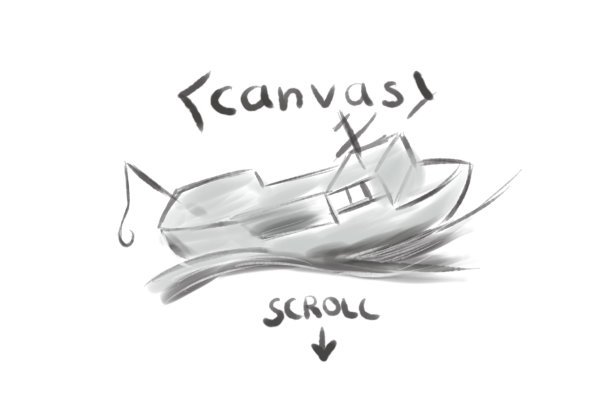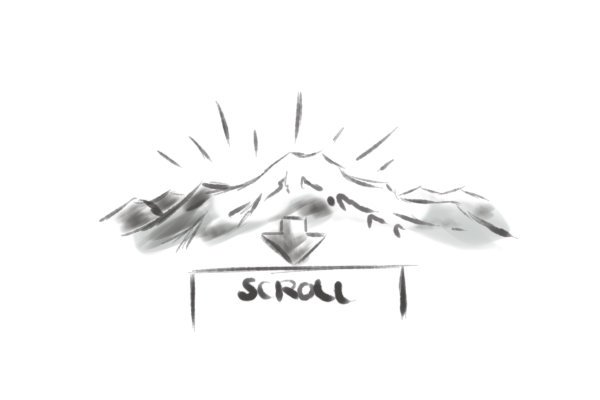Redefining Radio
The great thing about radio is that you can listen to it while doing something else – no need to remain stationary and fix your eyes on a glowing rectangle, or a paper one for that matter. With a podcast, essentially a downloadable or streamable radio show, you have the added benefit of listening whenever you want. I have spent countless hours listening to web design podcasts such as Shoptalk Show and Boag World while cleaning the bathroom or washing dishes. In a world where our attention is constantly divided and drained, I can still listen to two people talk for an hour or more every week, often on a very specific topic, because their disembodied voices are able to follow me around – or out of – the house. This is surely one of the main reasons why the grand-daddy of broadcast mediums has found a comfortable place in 21st century digital life.
The term ‘podcasting’ may well have been coined by Ben Hammersly in this Guardian article from 2004. 2004 was very much still the age of the iPod and although the iPod and iTunes have popular associations with the name and medium, podcasts are device-agnostic – most of them are simply mp3 audio files.
One of the key differences between a pure podcast and a radio show is the way in which the form and content of a podcast are shaped by the independent nature of its production. Podcasters embody the same frontier enthusiasm as bloggers, often independently producing shows focused on topics that would be too niche for mainstream airtime, circumventing the traditional gatekeepers of this airtime to occasionally reach global audiences. Despite this new freedom, I would argue it has taken podcasts backed by conventional broadcast media to push the idea of ‘listening to a podcast’ into the mainstream.
My first encounter with podcasting happened around 2006. I was living in Japan and would scrub my cubicle toilet while listening to BBC radio programmes such as Melvin Bragg’s ‘In Our Time’. These were broadcast radio shows streamed on-demand through BBC iPlayer. With the rise of on-demand media of all kinds, the boundaries between conventional radio and podcasting have become increasingly blurred. The BBC publishes its radio content as podcasts on iTunes as well as on BBC iPlayer. This 2016 article from The Guardian gives a list of selected podcasts, with a mix of mainstream broadcast and independent productions. Since 2006 I have produced a podcast series for English language teachers and the pilot episode for a fictional drama about English teachers in Japan – the former a company-sponsored show aimed at a very specific professional group, the latter a product of the DIY ethos.
Human Interest
Along with radio programmes on BBC iPlayer, the hybrid format of broadcast/podcast can be found in This American Life, an on-air Chicago Public Radio show and also one of the most popular podcasts in the world. The show is hosted by Ira Glass, a seasoned broadcaster with a knack for creating narrative tension through his natural, unforced delivery – a practised style which, by his own admission, took him many years to perfect. Each episode hangs a loose theme over various human interest stories, offering a mixture of surprise, humour and self-reflection, often with a socially conscious dimension to it. The reason why This American Life tops the charts is no-doubt a reflection of the type of general audience that listen to podcasts. Another similar hybrid radio show/podcast is Radiolab from New York Public Radio. Radiolab is more experimental in its use of soundscapes and audio effects. While the topics are broadly science-based, the show still focuses on storytelling through personal testimony and the lively banter of the hosts.
I have already written about how text can be transformed by web technologies. A simple example of how this relates to podcasting is the way in which This American Life publishes both a clean version of the show where strong language is bleeped out along with an uncensored version – something that would be impossible with conventional broadcasting. The show’s website also offers some basic additional material for those interested in creating their own podcast, featuring video clips of the makers, including Glass, talking about the practice of finding, researching and telling a good story.
What Happens Next?
In 2013, the producers of This American Life created the Serial podcast. Unlike its parent show, Serial was only available through the web, with iTunes being the most prominent distribution channel. The show has been marked out as the tipping-point for the podcast as a form of popular media, achieving the kind of public recognition (and, indeed conventional media coverage) reserved for films and TV shows. The obvious litmus test for Serial is whether or not you have heard of it. Serial has been featured everywhere from Buzzfeed to the Late Show with Stephen Colbert. By contrast, the interactive article ‘Snow Fall’ was mainly talked about by the web community. Even if you are interested in web storytelling, you are far less likely to have heard of it, than the Serial podcast.
When I first heard about Serial I mistook it for an elaborate work of online fiction. I also thought that it would involve a significant amount of extended multimedia content. I made these two assumptions based on the layout of the website which featured a map of a convenience store and a number of links inviting you to explore further evidence. I thought it was perhaps some whodunnit which would involve the listener/user working out clues. This wasn’t too far from what the show actually turned out to be.
The first series of Serial presented one true-life story concerning the brutal murder of a high school girl and the inconclusive case against her already convicted and imprisoned boyfriend. Although the event occurred back in 1999, the show’s producers had made contact with a campaigner who was trying to get the case reopened. Serial’s journalists carried out a live investigative report with new details emerging every week. The show’s popularity was down to this ‘real-time’ investigative journalism deploying the same polished storytelling techniques as This American Life. In particular, these techniques involve a kind of zooming out from and then into the different aspects of the story – standing back for a moment to explore the wider context or peering in to examine a particular moment in time.
The Reddit Transformation
While there was kind of virtuoso journalism being carried out by the show’s host and principle journalist, Sarah Koenig, the show also raised many questions about journalistic ethics. In particular, the popular discussion website Reddit became host to speculative threads on the series with amateur sleuths trying to find and post the addresses of the people involved in the case. One of the main characters under scrutiny went to online feature website The Intercept to tell his own side of the story. In a similar way to ‘Snow Fall’, we are on a perilous edge, creating compelling and innovative content out of real personal tragedy – in this case we also have an unwelcome dredging up of the past as people who had attempted to put the murder to the back of their minds were suddenly asked or felt compelled to answer questions over the phone or on their doorstep, even if this was done in the spirit of challenging a possible miscarriage of justice. True life stories – particularly tragic ones – are perhaps the most engaging but also the most delicate to handle. The unofficial digital transformations of Serial’s investigation via Reddit meant that this sensitivity was taken out of the hands of the producers and displaced into the rowdy, unaccountable and often anonymous milieu of the internet discussion forum. The prominence of Reddit discussion should be included as part of Serial’s impact and certainly went a large way to foregrounding the more controversial aspects of its presentation.
Dreaming of a Bigger Picture
With ‘Series 2’ there is more of an attempt to make the Serial website into a multimedia experience, now even closer to what I initially mistook Serial to be. Exhibiting a similar but less-experimental inter-connectivity to ‘Kafka’s Wound’, we have a ‘central text’ of audio episodes linked to supplementary content fragments. There are interactive maps similar to those seen in ‘Snow Fall’, infographics showing army uniforms, along with additional audio and video clips. The extra material adds further context to the episodes but comes across as peripheral. There is no tight integration between the listening experience and the browsing experience. I find that listening to a podcast episode and browsing the serial website are two distinct activities – the listener and user are split, so one does not displace your attention to the other, whereas reading an interactive article like ‘Snow Fall’ is more integrated, but perhaps more in danger of displacing attention.
The supplementary material is perhaps necessary to an extent since the topic is way more ambitious and convoluted than Series 1. We move from a small-town murder that became a national news story because of the show to a national news story that taps into wider issues of American foreign policy and international affairs. Serial 2 takes up the case of Sgt Bow Bergdahl, an American soldier captured by the Taliban in Afghanistan and held in solitary confinement as a hostage for over five years before being released in a hostage trade deal, only then to be labelled as a deserter who had caused many problems over the years for the ground troops tasked with locating him.
Koenig does not interview Bergdahl directly but plays excerpts from his recorded phone conversations with filmmaker Mark Boal who interviewed him while gathering material for a screenplay. At one point Koenig interviews a key member of the Taliban who claimed to have captured and held Berghdahl in Afghanistan. Many of the later episodes ‘zoom out’ to wade through the mire of American politics and diplomacy. While series 2 has plenty of time to tell its story, including a two-part episode released in the same week, it struggles to keep the focus on the network of relationships and character portraits which I imagine appealed to many listeners of the first series. The show’s producers commissioned distinctive animated artwork from Carl Burton to create a sense of imaginary space for each episode – a visual cue for listening. These images have a dreamlike quality and for me recall the stylised Flash animation of the film Waltz with Bashir. The effect is radically different to reading about the events on a conventional news site. I think this was partly an attempt to evoke the digital impressionism of 3D video games – something to do with locating the podcast as part of a wider contemporary experience.
While Serial may have succeeded in raising the profile of the podcast as a form of mainstream media it does not transform the podcast into something radically different from a conventional radio show – and that might be a good thing considering the fragmentary experience of the supplementary material. Meanwhile, the independent podcasts with their quirky non-mainstream obsessions will continue to attract their niche audiences.
If you have not listened to Serial season’s 1 or 2 yet, I will leave you to do so without dissecting the final outcome. You can find more than enough dissection elsewhere on the web.
Key Links
- This American Life website
- Serial website
- Serial Reddit discussion forum
- Ira Glass writes about Radiolab
- Radiolab website
- Guardian article on podcasts
- Hindenburg audio software aimed at radio and podcast production





